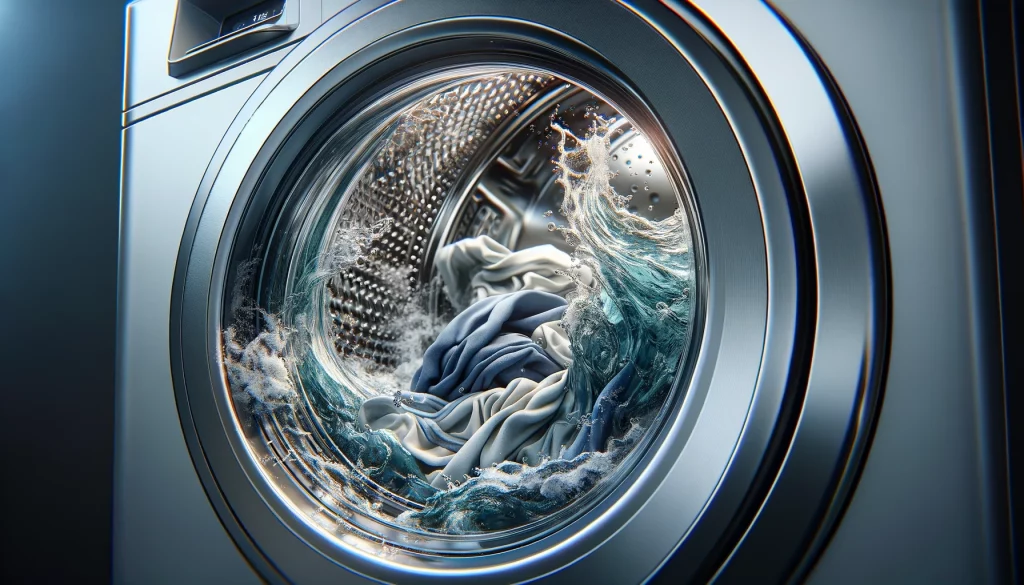Unlock the secrets to flawless laundry with our insightful guide on mastering washing machine settings. Whether you’re refreshing everyday basics or delicately handling treasured garments, knowing the right cycle can make all the difference. For more tips on garment care and to explore a collection of unique apparel, visit inktasticmerch.com and discover how to keep your clothes looking their best.
Navigating the complexities of laundry cycles can often feel puzzling. With so many options on your washing machine, determining the ideal setting for your garments can be quite challenging. From delicate lace to bulky bedding, each fabric necessitates particular attention. Washing machines boast an assortment of cycles tailored to diverse clothing types and soil levels. This article dissects those cycles and provides guidance on choosing the optimal settings for your laundry needs.
Key Takeaways
- Selecting the appropriate laundry cycle is influenced by fabric type and the degree of dirtiness. Delicate cycles are suitable for gentle fabrics, while heavy-duty settings tackle stubborn stains.
- The temperature of the water impacts both cleaning efficiency and energy consumption. Warm water suits most garments, whereas cooler temperatures preserve delicate items.
- Additional features like extra rinse or steam clean enhance cleaning performance. Adjust soil level settings according to the dirtiness of your clothing for optimal results.
- Avoid overloading your washing machine to prevent dirt entrapment and machine strain. Balanced loads conserve energy and avert damage.
- Line drying is energy-efficient, and washing similar-colored items together prevents color bleeding, ensuring your clothes maintain their vibrant appearance longer.
The 7 Washing Machine Cycles Explained

Your washing machine features seven distinct cycles designed to tackle various laundry challenges, tweaking the wash to accommodate different fabrics and dirt levels, ensuring your clothes come out both clean and cared for.
| Cycle Type | Description |
|---|---|
| Normal | Perfect for everyday wear such as t-shirts, underwear, and cotton items, combining a high-speed wash with a high-speed spin. |
| Speed/Quick Wash | An expedited cycle for lightly dirty clothes that reduces washing time and saves energy. |
| Heavy Duty | Optimal for thick, heavily soiled fabrics and robust materials, utilizing hot water and a high spin speed. |
| Bulky | Ideal for oversized items like blankets and comforters, employing a high-capacity cycle. |
| Bedding and Sheets | Uses heavy duty or bulky settings for soiled linens; normal cycles suit regular washes. |
| Delicate/Hand Wash | For items requiring gentle handling like silks and intimates, mimicking hand washing with low agitation. |
| Rinse and Spin | Eliminates detergent residue through a blend of water and spinning, ensuring clothes are fully rinsed. |
Normal
The Normal cycle serves as the cornerstone setting for washing machines. Combining high-speed wash with high-speed spin, it delivers a powerful yet efficient clean for everyday apparel.
This cycle effectively washes items like t-shirts, underwear, socks, and cotton garments through its robust process.
The Normal cycle reigns as the most intensive setting, designed to thoroughly clean everyday clothes with high agitation and prolonged cycles.
Speed or Quick Wash
Speed or Quick Wash settings provide an expedited solution for lightly soiled garments, merging a brief wash cycle with high-speed spins. This proficient wash cycle utilizes warm water and a swift spin speed to ensure clothes are quickly cleaned.
Speedily cleaning while cutting down drying time, the quick wash cycle is perfect for bustling lifestyles. Designed for efficiency without compromising on cleanliness, it’s perfect for refreshing clothes that require a gentle touch rather than a deep clean.
This swift cycle makes laundry less time-consuming, offering a fabulous option when you’re racing against the clock. A high-speed spin ensures clothes are less damp, easing the drying process whether you hang them out or pop them in a dryer.
Convenient and time-efficient, the Speed or Quick Wash setting is a must-have for modern households eager to enhance their chore routine while ensuring top-notch cleaning.
Heavy Duty
For a deep clean, the heavy duty cycle is indispensable. Utilizing hot water and a vigorous spin, it skillfully handles thick, heavily soiled fabrics. With its powerful wash action, it’s ideal for hardy materials with stubborn stains and substantial dirt.
Perfect for large pieces like bedding, this comprehensive cycle ensures cleanliness through an extended wash time that leverages heated water, ideal for hefty loads needing robust cleaning.
However, reserve this setting for strong fabrics to prevent possible damage to delicate ones.
Bulky
The Bulky cycle is tailored for large items like blankets, comforters, and towels, adeptly managing oversized and thick textiles. This high-capacity cycle efficiently handles substantial wash loads.
For large and heavy fabrics, the bulky setting is crafted to deal with big or bulky items without causing any harm.
Bedding and Sheets
Always inspect fabric care labels before washing bedding and sheets. For heavily soiled linens, use heavy duty or bedding/bulky settings, while regular washes suit normal cycles.
Consider a cold wash to protect delicate fabrics and colors, and add an extra rinse & spin for heavily soiled items.
Choosing the appropriate cycle is key to keeping your bedding fresh and durable.
Delicate or Hand Wash
The Delicate or Hand Wash cycle is perfect for items needing tender care, such as silks, satins, and intimates. Emulating handwashing, it uses gentle agitation to clean without harming fabrics.
Ideal for laundry requiring a gentle touch, it maintains the integrity of wool and lingerie, ensuring thorough cleaning while preserving quality.
Opting for this setting reduces wear over time, making it a smart choice for prolonging the life of your cherished garments.
Rinse and Spin
Essential for removing detergent leftovers, Rinse and Spin cycles activate when a regular wash doesn’t eradicate all soap. By combining water and spinning, it ensures laundry is thoroughly rinsed and ready for drying.
This cycle ensures clothes are not only rinsed well but also efficiently spun to remove excess water. Understanding Rinse and Spin helps choose the best washer setting, making laundry much simpler and more effective.
Decoding Washer Settings

Enhance your laundry routine by mastering your washer settings, leading to more successful loads.
- Water Temperature: Plays a vital role in cleaning efficacy. Opt for warm water for most garments and cooler temperatures for more delicate items.
- Soil Level: Modulates the intensity of the wash cycle depending on your clothing’s dirtiness, with options for low, medium, and high settings.
- Water Level and Auto Sensing: Efficiently adjusts the water fill level based on the load size for better resource use.
Water Temperature
Water temperature is pivotal in defining fabric care and detergent performance. The Permanent Press setting, maintaining a range of 85-105 degrees Fahrenheit, effectively reduces wrinkles.
Washing machines offer varied temperature settings for the wash and rinse stages. The washing phase utilizes warmer water, while the rinsing stage employs cooler temperatures.
Selecting the proper temperature affects energy consumption and water efficiency. Higher temperatures clean heavily soiled clothes well but use more energy, while cooler settings are gentler on fabrics and conserve energy.
Always align the water temperature with the fabric type and soiling level to maximize stain removal and protect your garments.
Soil Level
After determining the water temperature, tweak the soil level setting to match your clothing’s dirtiness. This feature adjusts the wash cycle intensity for optimal cleaning power.
With low, medium, and high options, selecting the right soil level ensures effective stain removal. A higher soil level involves more agitation and prolonged wash times to tackle persistent stains.
Optimizing the soil level enhances cleaning effectiveness by aligning cycle robustness with dirtiness levels, preventing fabric wear from unnecessary agitation.
Light settings suit slightly soiled fabrics without causing excess wear. Medium settings address typical stains, while high settings deeply clean heavily soiled items.
Choosing an appropriate soil level aligns the wash cycle with your laundry’s needs, conserving water and energy.
Water Level and Auto Sensing
Auto-sensing technology in washers intelligently adapts water levels to the load, ensuring efficient water use by only filling as needed.
Most models feature this setting, allowing water usage adjustments based on load size. The technology also stabilizes water levels during rinsing.
High-efficiency top-load washers excel in managing water use by assessing laundry load sizes. Understanding auto-sensing provides insight into washing machine mechanics.
This ensures thorough cleaning while conserving water and energy, particularly with smaller loads.
Steam Clean
Transitioning from water levels, the steam clean function offers exceptional laundry care through steam’s power. This cycle keeps tubs cleaner by minimizing residue, mold, mildew, and odors.
Some brands, like LG, extend steam cleaning to both garments and tub-clean cycles. Steam use fights grime and tough stains while reducing wrinkles and preventing shrinkage.
Steam excels in eradicating stubborn stains and odors in clothing. Selecting the steam cycle initiates deep-cleaning capabilities that amplify washing efficiency.
It goes beyond merely eliminating dirt from the surface.
Garments emerge not only fresher but also with noticeably fewer wrinkles, highlighting steam’s effectiveness in eliminating odors and preventing shrinkage. This feature ensures that your clothes receive comprehensive care without harsh scrubbing or the overuse of detergents.
Extra Options
Once you grasp the benefits of steam cleaning, it’s time to delve into additional options your washing machine provides to further enhance laundry results. These features allow you to optimize your machine’s performance, ensuring clothes come out looking and smelling exceptional.
- Extra Rinse: This adds an additional rinse cycle, perfect for removing excess detergent, especially from towels and other thick items.
- Pre-Wash: Before the main wash, a pre-wash loosens dirt and stains on heavily soiled clothes.
- Delay Start: Set your laundry to begin at a future time, ideal for utilizing off-peak energy hours.
- Steam Option: Apart from a dedicated steam cycle, some machines offer steam in regular cycles for more thorough cleaning.
- Soil Level Adjustment: Adjust the wash cycle intensity based on the degree of dirtiness, with higher soil levels resulting in longer cycles.
- Water Level Auto Sensing: Machines with this feature automatically determine the necessary water amount by assessing the load size, conserving both energy and water.
- Spin Speed Control: Alter the spin speed to manage drying, with slower speeds minimizing wrinkles in delicate fabrics.
- Child Lock: Prevent unintended changes during the washing cycle by locking the controls, a valuable feature for families with children.
Utilizing these extra settings allows you to customize each wash according to specific laundry needs, maximizing your washer’s capabilities for superior cleaning results.
Tips for Choosing the Right Cycle

Selecting the appropriate cycle involves understanding your fabric type and the level of cleanliness needed. Discover more tips to perfect laundry day!
- Fabric Type and Care Instructions: Match the cycle to the type of fabric (e.g., delicate fabrics on delicate cycles).
- Level of Dirt and Stains: Apply suitable soil settings to tackle varying degrees of dirt.
- Water Temperature and Level: Adjust the temperature and water level based on the clothing type and soil level.
- Utilize Extra Options: Employ features like Extra Rinse or Steam Clean for enhanced cleaning performance.
- Don’t Overload the Machine: Balance loads to ensure optimal cleaning and machine efficiency.
Consider Fabric Type and Care Instructions
Different fabrics require specific cycles to maintain their integrity. Delicate materials like silk or wool are best suited for the delicate cycle, preserving their quality over time.
Always refer to the care labels on your garments before selecting a wash cycle. This guarantees that your clothes receive appropriate treatment and have a longer lifespan.
Understanding each fabric’s requirements can prevent damaging your cherished items. Materials like cotton and linen generally endure regular cycles, whereas more delicate fabrics might prefer softer handling.
Match soil levels to the material and wash cycle for optimal care.
to enhance your laundry routine while ensuring garments remain spotless and intact. Proper fabric care is essential for long-lasting clothing quality.
Assess Dirt and Stain Levels
Begin by evaluating the degree of dirtiness on your clothes to determine the appropriate wash cycle. Washing machines come with soil level settings that align the cleaning intensity with the level of dirt or stains present.
For clothes that are only slightly dirty, a lower soil setting is sufficient and conserves energy. However, for heavily stained or deeply soiled garments, opting for a higher soil level will lead to more effective cleaning.
Selecting the right soil level is crucial for eliminating stubborn stains and ensuring cleanliness.
Heavily soiled items, like those encrusted with mud or drenched in sweat, require a normal cycle with a high soil setting. This guarantees enough water and agitation to dislodge and wash away dirt thoroughly.
Always inspect your clothes closely to choose the soil level that best matches their condition before washing.
Select Optimal Water Temperature and Level
Choosing the correct water temperature is vital for proper laundry care. Warm water, between 105°F and 120°F, is ideal for most fabrics and effectively removes dirt without harming them.
Delicate items should be washed in cooler water to prevent shrinkage and maintain fabric strength, ensuring gentle handling during the cycle.
The correct water level is also important, particularly when dealing with bulky or heavily soiled items. The Deep Fill feature accommodates more water in the basket, allowing clothes to be entirely submerged for a thorough clean.
For standard loads, using auto-sensing or medium water levels will save water while still achieving cleanliness.
Leverage Additional Options for Superior Cleaning
After selecting the proper water temperature and level, consider utilizing extra options for enhanced cleaning efficacy. For absorbent items like towels, the Extra Rinse feature helps eliminate any soap residue.
This prevents stiffness and keeps materials soft. The PowerWash® cycle on certain Maytag® machines is ideal for obstinate stains, combining additional wash action with optimal settings.
This advanced feature effectively removes tough stains in one cycle without damaging the fabrics.
For maximum cleaning power, don’t hesitate to employ these advanced washing features. Tough stain removal becomes manageable with the right cycle and supplementary options available.
Improved detergent removal also results in fresher-smelling, cleaner clothes. By selecting advanced rinsing features designed for potent cleaning, you ensure each load emerges looking pristine.
Avoid Overloading the Machine
Packing the washing machine too heavily can result in improperly cleaned clothes. It can stress the machine and consume more energy than necessary. Always adhere to proper load capacity guidelines to keep your laundry clean, maintain your machine, and conserve energy.
Overloading causes noise during the spin cycle and imbalances the drum. Keep loads balanced for quieter operation and to prevent damage. Select the appropriate cycle to avoid overloading issues, ensuring each garment receives proper attention without straining your washer for peak performance.
Additional Tips and Tricks for Laundry Success

Discover innovative techniques to maximize your laundry’s efficiency and ensure impeccable results every time.
Ensure your laundry is both fresh and efficient by exploring more tips to keep your clothes in pristine condition.
- Use a Finishing Spray: Elevate the fragrance and freshness of your laundry.
- Line Dry for Energy Savings: Minimizes energy consumption while preserving your clothing’s longevity.
- Wash Like-Colored Items Together: Avoids color transfer and protects the fabric’s quality.
- Properly Store Clothes for Seasonal Wear: Opt for breathable fabric bags or boxes for storage solutions.
Use a Finishing Spray for a Fresher Scent
A finishing spray provides a quick way to keep your laundry smelling fresh, enhancing the aroma of clothes, towels, and bedding for longer-lasting fragrance.
After washing, apply a scented fabric spray to introduce a delightful scent. This booster acts as an effective odor eliminator. For those who love a fragrant final touch, a clothing freshening spray ensures your garments smell pleasant even days post-launder.
Line Dry for Energy Savings
Line drying is a straightforward method to lower your energy bills. Hanging clothes on a line or rack bypasses the expense and energy-intensive nature of a dryer, contributing to an eco-friendly, sustainable laundry routine.
While ENERGY STAR certified heat pump dryers offer savings over traditional models, air drying offers even greater energy reduction. Filling your washing machine with full loads also decreases energy consumption over time.
This eco-conscious drying approach not only saves energy but also extends your clothing’s lifespan by avoiding tumble dryer wear.
Wash Like-Colored Items Together
Keeping like-colored items together in the wash maintains their appearance. This strategy prevents brighter or darker colors from bleeding onto lighter ones.
Sort your laundry by color before starting to preserve fabric quality and vibrancy. Employ detergents suitable for specific fabrics and adhere to care instructions on clothing tags for optimal results.
Correct sorting prevents color transfer and ensures prompt removal from the machine, enhancing laundry room organization and achieving efficient wash cycles.
Properly Store Clothes for Seasonal Wear
Before storing season-specific clothing, ensure they are clean and repaired. Opt for breathable fabric bags or boxes to shield them from dust while allowing airflow. Though vacuum-sealed bags save space, use them cautiously as they may compress and damage delicate fabrics.
Delicate items gain extra protection from acid-free tissue paper to prevent creases. Arrange heavier items at the bottom of storage containers to avoid crushing lighter pieces. Lavender sachets or cedar blocks repel pests, maintaining your wardrobe’s freshness.
Store containers in cool, dry areas away from direct sunlight to prevent fading and moisture damage. Organize and label by season for convenient access when needed.
Subscribe to Rinse for Convenient Laundry and Dry Cleaning Services
Once your clothing is safely stored, consider simplifying laundry day even more with Rinse. They offer hassle-free laundry and dry cleaning services.
Rinse picks up your laundry at your convenience, cleans each item to meet its fabric’s needs, and returns them ready to wear. With Rinse, managing laundry and dry cleaning becomes effortless.
letting you concentrate on the truly significant moments in life.
Rinse recognizes that each fabric demands unique attention. They offer an array of services tailored to every type of garment, from exquisite silks to your everyday cottons. Their skilled team applies the optimal washer settings and techniques for each fabric category, ensuring your apparel returns in pristine condition.
Rely on Rinse for a stress-free laundry and dry cleaning service that suits your bustling lifestyle perfectly.
Conclusion
Grasping your washing machine’s cycles and settings can conserve time and protect your clothing. The proper cycle preserves the appearance of fabrics. Water temperature, soil level, and extra options boost cleaning efficiency without causing damage.
These decisions transform laundry from a burden into a streamlined task. Mastering the alignment of cycles with fabric types enhances the longevity of your wardrobe. Your diligence results in fresher, cleaner apparel with each wash.
FAQs
1. What does the “regular” cycle on my washing machine do?
The “regular” cycle efficiently cleans everyday garments with a standard amount of dirt.
2. When should I use the “delicate” cycle?
Opt for the “delicate” cycle for items prone to damage, such as silk or lace.
3. Is there a specific cycle for heavily soiled clothes?
Indeed, select the “heavy duty” or “deep clean” cycle for garments heavily stained or soiled.
4. Can I wash all types of fabric in the “permanent press” cycle?
The “permanent press” cycle is ideal for synthetic fabrics, minimizing wrinkles and creases.
5. How do I choose between cold, warm, and hot water settings?
Use cold water to conserve energy and prevent color bleeding, warm water for synthetics, and hot water for whites or heavily soiled items.
To further enhance your laundry skills and explore a wealth of tips for garment care, visit our Blog for more insightful articles and advice.




